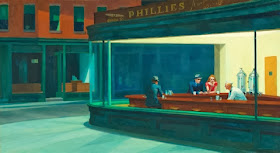 |
| Norman Rockwell, Freedom From Want, 1942 |
Art and Appetite: American Painting, Culture, and Cuisine
Art Institute of Chicago (Exhibit Website)
Thru January 27, 2014
@@@@
In exploring the Art Institute's new exhibit of food-related paintings by American artists, it occurred to me that there are two ways for an art exhibition to be terrific (at least in my eyes).
One is simply to have a plethora of awe-inspiring artworks on display, whether representing a specific artist, genre or theme. Certainly, the paintings (and perhaps a few sculptures) should be intelligently-arranged and enhanced by insightful wall text, but the pictures themselves are clearly what make such an exhibition “Great!”
But, as was the case here, an exhibit can be “Great!” even when the artworks—relatively speaking, of course—can only be collectively described as good.
For an exhibition is in itself an artistic work, and can in fact be better than the sum of its paintings. (Though the AIC's summertime Fashion, Modernity and Impressionism exhibition had a stronger gathering of paintings than this one, I similarly felt that the exhibit itself was even better than its collected works.)
 |
| John Sloan, Renganeschi's Saturday Night, 1912 |
For example, in the first gallery, themed around Thanksgiving—the exhibit opened on November 12—the aforementioned Rockwell and Roy Lictenstein's representation of a turkey were pleasures to see, but I also valued learning that Thanksgiving as an actual holiday doesn't date to pre-colonial times with Pilgrims and Indians, but rather was declared by President Lincoln during the Civil War.
 |
| William Glackens, At Mouquin's, 1905 |
It was conveyed that—except for a few, primarily within hotels—restaurants largely didn't exist in America until the Civil War, and in a room with Glackens' painting of a posh French restaurant in NYC and Sloan's capturing of a more Bohemian Italian eatery, the gallery introduction explained how immigration changed "dining out" through the influx of ethnic cuisines.
I also appreciated learning that the term "conspicuous consumption" was coined in 1899--by Thorstein Veblen, an economist and sociologist--amidst the "Gilded Age," but that most artists felt more comfortable depicting modest meals rather than glorifying ostentation.
All this isn't to imply that there aren't many excellent paintings, well-organized in themed galleries that allowed for the factoids I cited to be illustrated.
In addition to those already mentioned, there are paintings by John Singleton Copley, William Merritt Chase, John Singer Sargent, Edmund C. Tarbell (an American Impressionist reminiscent of Degas), Stuart Davis, Thomas Hart Benton, Andy Warhol (a Campbell's Soup Can), Tom Wesselmann and Wayne Thiebaud, whose Salads, Sandwiches and Dessert is one of the images most used to promote this exhibition.
 There are also three works by the great Pop Art sculptor Claes Oldenburg, including "soft sculptures" of green beans and a fried egg, as well as a piece of wedding cake made of plaster (one of 250 actually handed out at a wedding in 1966).
There are also three works by the great Pop Art sculptor Claes Oldenburg, including "soft sculptures" of green beans and a fried egg, as well as a piece of wedding cake made of plaster (one of 250 actually handed out at a wedding in 1966).
So if you're an Art Institute member like me or are able to spend several hours at the museum to better justify the admission fee of up to $23--which includes the museum's permanent collection and special exhibits like this one--Art and Appetite certainly provides enough visual and educational nourishment for a exploration worth savoring.
That said, due to the Art Institute's magnificence across many genres, there are dozens of paintings in the permanent collection that are far superior to most hanging in this fine exhibit. So if you're a rare and/or out-of-town visitor to Chicago's best museum--and one of the 10 best art museums in the world, IMHO--Art and Appetite is likely worth only a relatively small portion of your time.
But if you can, don't just consume the appetizing pictures; take time to also devour the writing on the wall.
---
 |
| Richard Estes, Food City, 1967 |
 |
| Peter Blume, Vegetable Dinner, 1927 |
 |
| Marsden Hartley, Fisherman's Last Supper, 1940/41 |
 |
| Edward Hopper, Nighthawks, 1942 |
 |
| Archibald John Motley, Jr, Nightlife, 1943 |
 |
| Edmund C. Tarbell, Breakfast Room, about 1903 |
 |
| Andy Warhol, Campbell's Soup, 1945 |

No comments:
Post a Comment